
The standard circulating coinage of the United Kingdom, British Crown Dependencies and British Overseas Territories is denominated in pennies and pounds sterling, and ranges in value from one penny sterling to two pounds. Since decimalisation, on 15 February 1971, the pound has been divided into 100 (new) pence. Before decimalisation, twelve pence made a shilling, and twenty shillings made a pound.
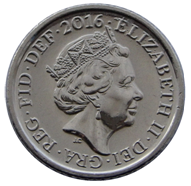
The British decimal five pence coin is a denomination of sterling coinage worth five one-hundredths of a pound. Its obverse has featured the profile of Queen Elizabeth II since the coin’s introduction on 23 April 1968, replacing the shilling in preparation for decimalisation in 1971. It remained the same size as the one shilling coin, which also remained legal tender, until a smaller version was introduced in June 1990 with the older coins being withdrawn on 31 December 1990. Four different portraits of the Queen have been used, with the latest design by Jody Clark being introduced in 2015. The second and current reverse, featuring a segment of the Royal Shield, was introduced in 2008.

The British crown was a denomination of sterling coinage worth 1/4 of one pound, or 5 shillings, or 60 pence. The crown was first issued during the reign of Edward VI, as part of the coinage of the Kingdom of England.
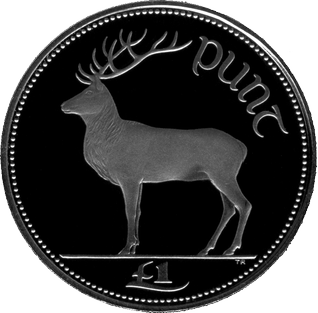
The pound was the currency of the Republic of Ireland until 2002. Its ISO 4217 code was IEP, and the symbol was £. The Irish pound was replaced by the euro on 1 January 1999. Euro currency did not begin circulation until the beginning of 2002.

Decimal Day in the United Kingdom and in Ireland was Monday 15 February 1971, the day on which each country decimalised its respective £sd currency of pounds, shillings, and pence.

The Jamaican dollar has been the currency of Jamaica since 1969. It is often abbreviated to J$, the J serving to distinguish it from other dollar-denominated currencies. It is divided into 100 cents, although cent denominations are no longer in use as of 2018. Goods and services may still be priced in cents, but cash transactions are now rounded to the nearest dollar.
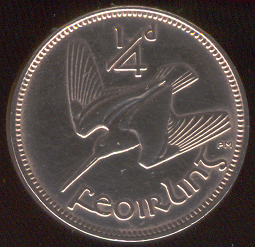
The farthing was the lowest value coin of the pre-decimal Irish pound, worth a quarter of a penny, 1⁄48 of a shilling or 1⁄960 of a pound. The coin had lost much of its value through inflation long before decimalisation in 1971, and during the 1960s no farthings were produced for general circulation; those minted in 1966 were produced for collectors' sets.
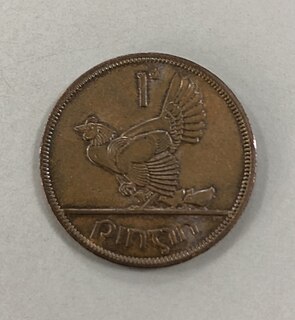
The penny (1d) coin was the third smallest denomination of the pre-decimal Irish pound, worth 1⁄240 of a pound or 1⁄12 of a shilling. To express an amount, penny was abbreviated to "d", e.g. 1d, from the Roman denarius. It was introduced in 1928 to replace its British counterpart, used when all of Ireland was a constituent country of the United Kingdom. The last year of minting was 1968 and it ceased to be legal tender on 31 December 1971.

The threepence or 3d coin was a subdivision of the pre-decimal Irish pound, worth 1⁄80 of a pound or 1⁄4 of a shilling. Leath reul literally means "half reul", the reul being a sixpence coin worth about the same as the Spanish real. As with all other Irish coins, it resembled its British counterpart, as the Irish pound was pegged to the British pound until 1979.
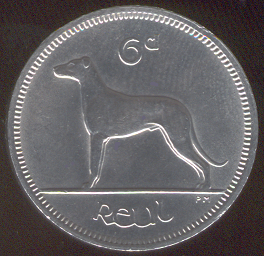
The sixpence coin was a subdivision of the pre-decimal Irish pound, worth 1⁄40 of a pound or 1⁄2 of a shilling. The Irish name réal is derived from the Spanish real; for most of the 19th century, a pound sterling was equal to five U.S. dollars, and a dollar was equal to eight reales, so that a real was equal to 1⁄40 of a pound. The variant spelling reul was used in the Coinage Act 1926, and appeared on the coins themselves even after a 1947 spelling reform established réal as the standard.

The florin (2s) coin was a subdivision of the pre-decimal Irish pound, worth 1⁄10 of a pound. It was more commonly known as the two-shilling coin.
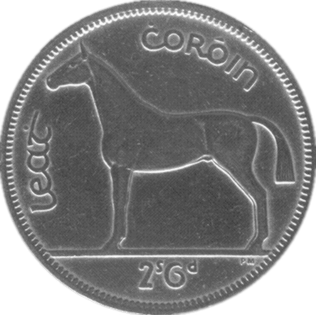
The half crown coin was a subdivision of the pre-decimal Irish pound, worth 1⁄8 of a pound. The half crown was commonly called "two and six" due to its value of two shillings and sixpence.
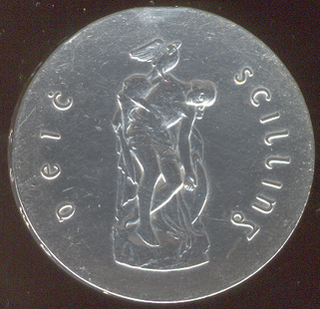
The ten shilling (10s) coin was a one-off commemorative coin issued in Ireland in 1966 to mark the 50th anniversary of the Easter Rising. Ten shillings was a subdivision of the pre-decimal Irish pound, worth 1⁄2 of an Irish pound, making this the highest value coin in the pre-decimal system.

The five pence (5p) coin was a subdivision of the Irish pound. It was introduced in Ireland on Decimal Day, 15 February 1971 and reused the design on the shilling coin produced for the Irish Free State in 1928. Some shilling coins remained in circulation until the early 1990s, with the same nominal value as the five pence coin.

The ten pence (10p) coin was a subdivision of the Irish pound. It was used in the Republic of Ireland from 1969 to 2002, with its last minting issue in 2000. It replaced the florin coin, of which it shared its design. Two different designs of the coin exist, both featuring a salmon on the reverse. The second was introduced in 1993 and is smaller, due to the reduction of the coin's value by inflation.
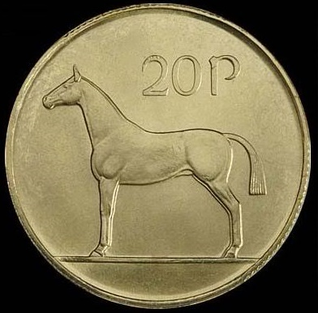
The twenty pence (20p) coin was a subdivision of the Irish pound. It was introduced on 30 October 1986. It was the first Irish decimal coin of a different size to the corresponding British coin, as the Irish pound had not been pegged to sterling since 1979. Its last issue was in 2000, two years before Ireland withdrew its pound for the euro.
There have been three sets of coins in Ireland since independence. In all three, the coin showed a Celtic harp on the obverse. The pre-decimal coins of the Irish pound had realistic animals on the reverse; the decimal coins retained some of these but featured ornamental birds on the lower denominations; and the euro coins used the common design of the euro currencies. The pre-decimal and original decimal coins were of the same dimensions as the same-denomination British coins, as the Irish pound was in currency union with the British pound sterling. British coins were widely accepted in Ireland, and conversely to a lesser extent. In 1979 Ireland joined the Exchange Rate Mechanism and the Irish pound left parity with sterling; coin designs introduced after this differed between the two countries.

The British sixpence piece, sometimes known as a tanner or sixpenny bit, was a denomination of sterling coinage worth 1/40 of one pound or half of one shilling. It was first minted in 1551, during the reign of Edward VI, and circulated until 1980. The coin was made from silver from its introduction in 1551 until 1947, and thereafter in cupronickel.
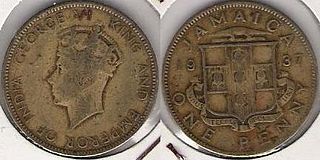
The pound was the official currency of Jamaica between 1840 and 1969. It circulated as a mixture of sterling coinage and locally issued coins and banknotes and was always equal to the pound sterling. The Jamaican pound was also used in the Cayman and Turks and Caicos Islands.

The British shilling, abbreviated "1/-", was a unit of currency and a denomination of sterling coinage worth 1/20 of one pound, or twelve pence. It was first minted in the reign of Henry VII as the testoon, and became known as the shilling, from the Old English scilling, sometime in the mid-16th century. It circulated until 1990. The word bob was sometimes used for a monetary value of several shillings, e.g. "ten-bob note". Following decimalisation on 15 February 1971 the coin had a value of five new pence, and a new coin of the same value but labelled as "five new pence" or "five pence" was minted with the same size as the shilling until 1990, after which the shilling no longer remained legal tender. It was made from silver from its introduction in or around 1503 until 1946, and thereafter in cupronickel.




















